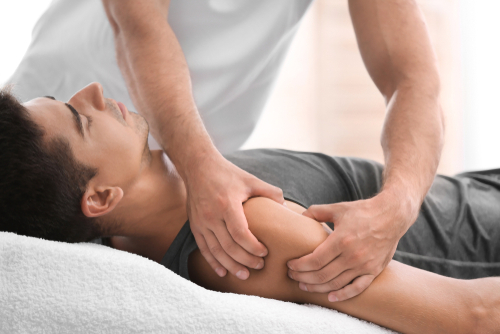Traumatic upper extremity injuries can be very painful. In addition to being painful, they can be a great hassle. We rely on our elbow, shoulder, and wrist health to perform the simplest tasks in life like driving cars and completing our daily routines. Many of us rely on our arms to carry out our professions. We can also give arms credit for allowing us to partake in our favorite hobbies like playing tennis or a musical instrument.
Even though our arms are extraordinarily useful — and perhaps because they are so useful — they are often subject to traumatic injuries. Six million Americans break a bone each year, including traumatic breakage of the upper extremity. Indeed, traumatic upper extremity injuries make up nearly half of all broken bones. Nearly half of these injuries — 45.4% — happen by accident at home, followed by the 16.2% that occur while playing sports. Because these injuries are so common in addition to being inconvenient, it is important that those experiencing traumatic upper extremity injuries be informed about potential treatment options.
Common types of upper extremity injuries
Because our arms are infinitely useful, there are several different types of upper extremity injuries one could experience. One type is trauma-induced injury. This may be caused by a car accident, aggressive sports such as football or even accidentally getting hit by a baseball bat.
Another type is fall-induced injury. When one falls, they may likely attempt to save the fall by landing on their hand or hands. This is problematic because this often results in injuries that take place anywhere between the wrist and the shoulder, depending on the position of the hand and the person’s age. Wrist and shoulder injuries are most likely to occur during a fall-induced injury.
Both trauma-induced and fall-induced traumatic upper extremity injuries can result in:
- Fractured bones — The force of a fall or the impact during sports can lead to a traumatic arm fracture.
- Sprained ligaments — Fall or sports impact also place great stress on ligaments throughout your upper extremities. You can easily sprain an upper extremity ligament if one is stretched too far.
- Torn rotator cuffs — A rotator cuff tear is a tear that occurs in one of four muscles and/or tendons within the shoulder. These muscles and tendons allow you to rotate and lift your arm. This is a very common injury. Rotator cuff injuries bring over 4.5 million Americans into doctor’s offices and about 40,000 Americans into surgery per year. This is why it is important to be aware of the way in which you brace yourself when you fall or how you hit another player during contact sports.
- Overworked tendons — Although this is not necessarily considered traumatic, tendinitis can make traumatic upper extremity injuries more likely to occur. Tendinitis is when your tendons become inflamed from microtears. Microtears can occur during repeated movements (often during sports) that cause stress on the tendons.
PT exercises and techniques that physical therapists can use to treat traumatic upper extremity injuries
There are certain physical therapy techniques that therapists may use to treat your upper extremity injury. Listed below are techniques that can help treat your pain and restore function.
Forearm extensor stretch
This wrist pronation stretch can help eliminate elbow pain when extending the arm. It targets the forearm extensor muscles that connect to the tendons on the outside of the elbow.
- What to do — Making sure your troubled elbow is against your side, bend it to 90 degrees with your palm facing down. Form a fist with your hand; then bend your wrist so that your fist is pointed toward the ground. Making sure your wrist is bent, slowly straighten your elbow. Then, point your downward-faced fist away from your body. Hold this position for 20 to 30 seconds. You should feel your forearm stretch. Complete two to four repetitions.
Wrist pronation stretch
The wrist pronation stretch can also help eliminate pain when extending the arm. This exercise targets the forearm pronation muscles that are also outside of the elbow.
- What to do — Placing your forearm on a flat surface, face your palm upward. Your hand and wrist should be extended over the flat surface. Making sure your palm is faced up, point your hand outward until you feel your forearm stretching. Hold this position for 10 to 15 seconds. Complete five to six repetitions, making sure to take a brief rest in between each.
Graston Technique®
The Graston Technique can help your traumatic upper extremity injury. Therapists use specially designed tools during this technique. They use them to encourage an increase in your range of motion, reduce restrictions of fascia (connective tissue that’s around nerves, muscles and blood vessels), and release scar tissue.
Active Release Techniques®
Active Release Techniques (ART) can also help your upper extremity injury by targeting the scar tissue by noninvasive means. Scar tissue is what often results after a soft tissue injury in your upper extremity. Your physical therapist can use their hands and the hundreds of ART movements in ways that help break up scar tissue.
Discover how SOL Physical Therapy can help treat your traumatic upper extremity injury
Beyond these physical therapy techniques, SOL Physical Therapy can formulate an individualized treatment plan that can address your specific upper extremity injury. Our philosophy of educating our patients and providing research-based treatment allows our services to be cost effective and efficient. We can also help you learn how to prevent future upper extremity injuries during your recovery.
Contact our team today for more information about how we can treat your upper extremity injury and symptoms or to schedule an initial appointment.


